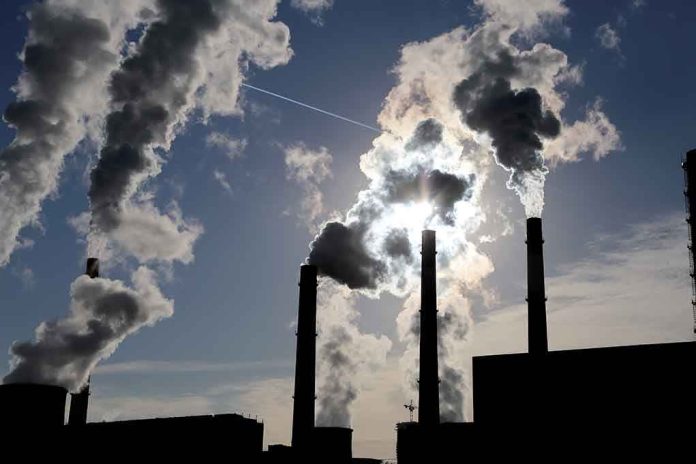
Pittsburgh is once again standing at the crossroads of American industry, and this time the stakes are higher: will the city’s new “AI revolution” become a blueprint for American renewal, or just another chapter in government-backed corporate fantasy?
At a Glance
- Pennsylvania is hosting a $70 billion Energy and Innovation Summit at Carnegie Mellon University, promising to make Pittsburgh the heart of a new tech-powered industrial revolution.
- President Trump, Senator McCormick, Governor Shapiro, and tech industry titans are converging to unveil massive investments in AI, natural gas, and infrastructure, with the goal of thousands of new jobs and economic revival.
- Amazon, Nippon Steel, and other mega-corporations are pouring billions into data centers and AI campuses, leveraging Pennsylvania’s natural gas boom and workforce.
- Critics warn that the rush to power AI with fossil fuels could worsen climate concerns, but supporters argue it’s the only way to reestablish American industry and dominance.
Pittsburgh’s Second Revolution: Real Revival or Corporate Shell Game?
Steel, coal, and oil built Pittsburgh’s legacy, and for decades, the city was ground zero for American grit. Now, after years of decline and government neglect, politicians and CEOs are dusting off the old playbook with a new twist: artificial intelligence, natural gas, and data centers. The Pennsylvania Energy and Innovation Summit on July 15, 2025, at Carnegie Mellon University isn’t just another ribbon-cutting. It’s being pitched as the moment America takes back its industrial destiny—from the leftists, the climate zealots, and every globalist who wrote off Middle America as “flyover country.”
This time, the so-called experts claim it’s different. Billions are pouring in: Amazon’s $20 billion for AI campuses, Nippon Steel’s $11 billion buyout to keep steel jobs alive, and a $10 billion plan to turn a shuttered coal plant into the nation’s biggest data center and natural gas power station. The word “innovation” is everywhere, but it’s hard not to notice how the same old power brokers—politicians, tech giants, and energy companies—are running the show, and asking taxpayers to clap along while they “transform” the region yet again.
Trump’s Return and the War for American Energy
President Trump’s presence at the summit says everything about where this new revolution is headed. The Biden years are over, and with them, the endless handouts to illegals, the climate fantasies, and the suffocating regulations that smothered American industry. Trump is back, and he’s making it clear: energy dominance and technology leadership are national priorities. The administration’s message is direct—power America’s future with American resources, American workers, and American sovereignty. It’s a full-throated rebuke to leftist governance, which prioritized subsidies for the “Green New Deal” over real jobs for real Americans.
Senator Dave McCormick, the summit’s chief organizer, isn’t shy about the stakes: “We are on the brink of America’s next industrial revolution… thanks to the technology that comes from [CMU] and the hubs of companies that surround it, as well as our incredible workforce to build these AI data power centers…” Everyone from Governor Shapiro to union leaders is lining up to claim credit for the coming boom. But let’s not kid ourselves. The real winners will be the companies and politicians who managed to survive the last round of deindustrialization, now rebranding their fortunes as “innovation.”
Promises, Pitfalls, and the Cost of Progress
The numbers sound impressive: tens of thousands of jobs, billions in investment, and a promise to transform Pennsylvania from a Rust Belt relic into a tech titan. For communities battered by decades of job loss and opioid crises, any hope is better than more empty promises from Washington. The data center boom means construction jobs, technical work, and real paychecks—at least for now. Amazon’s expansion alone is set to create thousands of jobs in Luzerne and Bucks counties, and the Homer City redevelopment brings new life to the ashes of coal country.
However, not everyone is buying the hype. Energy experts warn that powering these AI and data center behemoths will drive U.S. energy demand up by 25% in just seven years. That means more natural gas, more pipelines, and more emissions—exactly what the climate-obsessed left spent years demonizing. The irony is rich: the same crowd that wanted to shut down coal and oil is now quietly cheering as Pittsburgh’s natural gas keeps the servers humming for Amazon, OpenAI, and Meta. Meanwhile, the so-called “just transition” for workers means more retraining, more bureaucracy, and no guarantee that the next tech bust won’t leave them jobless again.
Who Benefits? Who Pays?
The summit’s bipartisan veneer is supposed to calm critics, but the power dynamics are plain as day. Tech companies and energy giants are calling the shots, politicians are basking in the glow, and labor unions are being tossed a bone to keep the peace. Local communities, battered and bruised by decades of broken promises, are being told to trust the same institutions that failed them before. The only thing “new” about this industrial revolution is the vocabulary. Now, it’s “AI-powered innovation” and “energy resilience.” But just like before, taxpayers will be on the hook if the bubble bursts—while executives cash their stock options and politicians move on to the next photo op.
Environmentalists warn about climate risks, but the summit’s real agenda is clear: American energy for American industry, no matter what the international panels or coastal elites say. The rest of the country might wring their hands over “sustainability,” but here in Pittsburgh, survival comes first. The jobs, the paychecks, and—yes—the pride of building something real again? That’s the revolution that matters.
Sources:
PoliticsPA: $70B in AI, Energy Investments for Pennsylvania
Fox Business: Trump to Meet Energy, Tech Titans in Pennsylvania Amid AI Dominance Push
Sen. McCormick: Pennsylvania Energy & Innovation Summit





